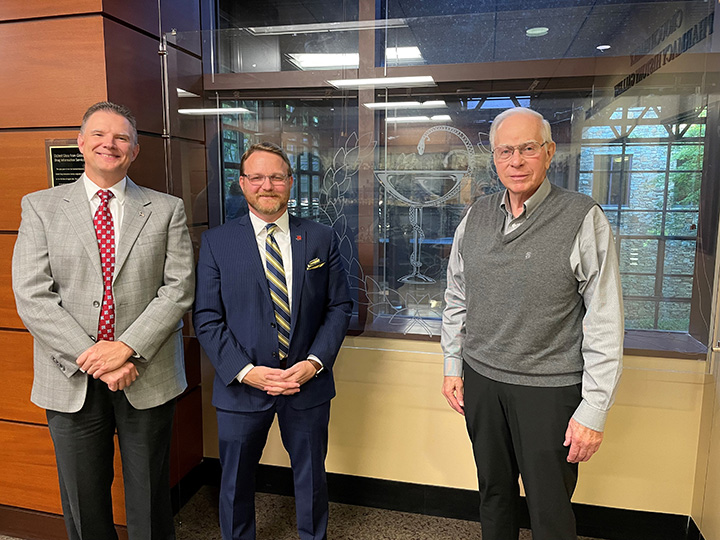
With its latest artifact, Samford’s McWhorter School of Pharmacy history gallery is experiencing some growing pane.
The Crouch Family Pharmacy History Gallery recently added a large etched glass pane depicting the Bowl of Hygieia—one of the most widely recognized international symbols of pharmacy—to its collection.
The piece was prominently displayed in the entrance to what was then Samford University's Global Drug Information Service (SUGDIS) in Ingalls Hall, Samford Pharmacy’s former home and the university’s current admissions center.
As part of American Pharmacists Month in October, McWhorter School of Pharmacy dean Michael Crouch hosted a dedication ceremony for the etching.
“There is no doubt we stand on the shoulders of the women and men who preceded us, but at the same time, each day we write the next chapter in the history of Samford Pharmacy,” Crouch said. “Although the drug information center closed in 2015 when we moved to the current College of Health Sciences, its legacy endures through the faculty, residents and students who worked and learned there.”
One such faculty member was Joseph Dean, who served as McWhorter School of Pharmacy’s dean from 1991 to 2006.
Dean, who attended the dedication, explained the history behind the Bowl of Hygieia, noting how it originated in Greco-Roman mythology, with the bowl containing a healing potion and the serpent representing wisdom or guardianship, both associated with Hygieia, the goddess of health. Dean was a recipient of the Bowl of Hygieia award, which recognizes significant contributions to the pharmacy profession.
The SUGDIS also represented wisdom and guardianship, by way of service. Offering consulting and informational services to a broad spectrum of pharmacists, it was founded in 1981 by the late Domingo Martinez, who served as both its director and a faculty member.
“He had a national and international reputation, and he really put all his efforts into creating a (center) that provided drug information services to local, state and international pharmacies,” said Mike Kendrach, pharmacy professor, executive associate dean and associate dean of academic affairs, who also directed the SUGDIS.
“Whether it was an institution, hospital, community pharmacy … we provided a lot of services to pharmacists. But more importantly, this drug information center was designed to help get the Pharm.D. program up and running, and this provided a great opportunity for our students to learn drug information skills, how to efficiently locate, critically analyze and effectively communicate information.”
The center also helped students bolster their problem solving, critical thinking and decision-making skills, Kendrach noted, adding that this work was done pre-Internet, meaning students had to employ more traditional methods of research.
“These were live questions, live activities that our students were working on,” Kendrach said. “These students knew that on the other end of that question, there was a patient or a pharmacist or somebody expecting a quality, evidence-based decision, recommendation or answer. And these students took that with pride, ensuring that they did their job to provide that service.”
To commemorate the SUGDIS, a plaque was installed next to the etched glass, noting how it “served as an active learning site for hundreds of pharmacy students.”
The Crouch Family Pharmacy History Gallery is located in the McWhorter School of Pharmacy lobby on the second floor of College of Health Sciences Building 2. The gallery was dedicated in February 2017 as a place to share and reflect on McWhorter School of Pharmacy’s storied history.
